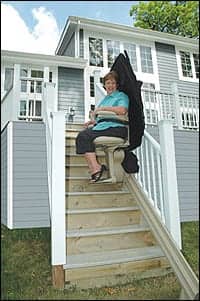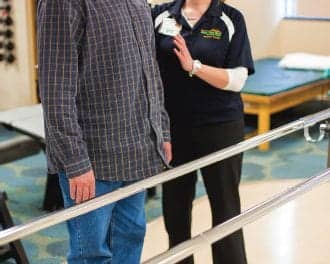 |
| Strategically placed lifts can increase a home’s overall market value. |
A decade ago, officials at Craig Hospital went looking for ways to reduce back injuries among therapists. They had plenty of portable lifts, but too often staff members elected to use muscle power rather than take the time to use the devices now almost universally referred to as Hoyer lifts.
As a premier center for SCI and traumatic brain injury patients, located in Englewood, Colo, Craig Hospital eventually bit the bullet and purchased more than 100 ceiling lifts from Guldmann, a company with headquarters in Denmark. “We were experiencing so many injuries—employee injuries and back injuries to physical therapists and nurses,” says Kenneth R. Hosack, MA, director of provider relations at Craig Hospital. “We installed overhead patient lifts in every patient room, and some of the common treatment areas.”
With a vibrant aquatic therapy program, Hosack even installed a lift over the 94° therapy pool, a move possible due to the pool’s relatively low 15-foot ceiling. Ten additional lifts were installed throughout the facility, with nothing less than stellar results. “These overhead lifts have dramatically decreased the number of employee back injuries to almost zero,” reports Hosack. “Of course, we also considered patient safety as well as employee safety when making this large purchase.”
Ceiling lifts use a sling similar to floor lifts, with the added benefit of saving floor space. In the residential setting, these space savings become even more valuable. “I have been in so many homes that have a floor lift crammed into a corner of the room collecting dust,” laments Louis Tenenbaum, a contractor, consultant, and certified aging-in-place specialist (CAPS) in Potomac, Md. “There is often not enough room to roll it. Ergonomically and logistically, it is less than ideal for the home.”
Christopher Lynch, president of Alternatives to Barriers, Hewitt, NJ, agrees with Tenenbaum and also discourages floor lifts in the residential setting. “As with any wheels, the bearings start to wear, and sometimes people swing around a lot and they are uncomfortable,” says Lynch, who specializes in the design of wheelchair-accessible residential environments. “For about $2,000 more, you can get the ceiling lift, and it lifts you directly up and saves that space.”
As a paraplegic himself for the past 30 years, Lynch says a ceiling lift installed on temporary freestanding stanchions was invaluable during a 4-month span when he was recovering from arm surgery. The equipment allowed him to transfer independently with only one arm, while doubling as a trapeze to allow him to move around the bed.
THE VISITABILITY MOVEMENT
Maryland and Georgia have pending ordinances in their state legislatures that will require so-called “visitable homes,” a term that USA Today reports is widely used overseas to describe homes accessible to people in walkers, crutches, or wheelchairs. “A study from the Journal of the American Planning Association shows that for every home built in the 2000s, there is a 25% chance that someone with a long-term disability will be living in that home,” says Tenenbaum. “There is also an AARP report on visitability that says where builders are not doing it [accessible building], they all claim it is going to cost $5,000 to $10,000 per house. All those that are actually doing it report the additional costs at about $0 to $500.”
Priming the home for a ceiling lift is one way to plan for the future. “I put a removable transom above the doors, and the bedroom to bathroom connection is built with a flat ceiling, so it is configured in a way that makes it easy to put in a ceiling track later on,” says Tenenbaum. “One of the keys is to not put a soffit over the top end of the shower, which is essentially a ceiling drop—often included for purely aesthetic reasons. It is easy to plan for this lift technology, and it is incredibly helpful.”
Tenenbaum points out that straight lines for ceiling tracks are not needed since the track systems have curves for corners and doorways. Double axis installations can provide full room coverage, and less complex systems use wheelchairs or rolling shower commode chairs so that separate tracks in various rooms can be connected. “The system is almost unlimited, but the strategy can be holistic,” adds Tenenbaum. “One way to assure a path is to consider the concept of universal design or basic ‘visitability’ before construction even starts, so maneuvering becomes a design criterion. For new homes, this concept has taken hold in various parts of the country.”
Some cities are asking, but others are forcing, builders to incorporate at least three elements into all new homes. According to a September 2008 article in USA Today by Haya El Nasser, those elements include: 1) no steps at the entrance; 2) a bathroom on the ground floor; and 3) wider doorways. “There are about 25 different ordinances in various communities across the United States,” says Tenenbaum, who also goes by the title of independent living strategist. “For example, all homes must be built ‘visitable’ in Pima County, Az, and there have been about 25,000 homes built in this manner in Bolingbrook, Ill. But they don’t do this in other places because there is not a law requiring it.”
Tenenbaum and Lynch agree that once you build that no-step entry along with easily maneuverable halls, you not only have a disability-friendly home, but potentially a greater resale value. For seniors with limited mobility and significant investments in their homes, a stair glide is yet another value-adding option. If there is a straight set of stairs, Lynch reports that cost often hovers around $2,500 to $4,500. Stairs with turns could add up to $15,000.
For full-time wheelchair users, Lynch recommends a full-cab elevator as a much safer and quicker option. On the inside, Lynch prefers to build a shaft on the outside of the house, which then requires only a door to pop through the wall. For getting patients up to the porch level, a simple platform lift is the number one device for the outside.
For significant porch elevation jumps of up to 3 feet, Lynch looks for a level means of access, which requires a lift or a gentle ramp. There are no ramp codes for single family homes, so residents can theoretically ask contractors to build any pitch they choose. However, Lynch points out that when wheelchair users are pushing up a steep ramp, they often need to bend over their legs to counterbalance the chair. “If I am leaning over my lap, I can’t carry anything in my lap,” muses Lynch. “I can’t put a bag of groceries on my lap and push, because it is just going to get knocked over. Can I get in and out of the house? Yes. But am I functional? To a large degree, no.”
The commercial code is one foot of ramp for every inch of vertical height. If residents wish to adhere to code, it quickly becomes evident that a sea of ramp switchbacks may not be the ideal solution. “A vertical platform lift is a glorified forklift with a platform, and they run by either a worm screw drive or a chain over hydraulic, and these lifts take up about 25 feet instead of hundreds of square feet for a ramp,” says Lynch. “You can hide it behind a couple of bushes, and it is a level means of access. You can have something on your lap and be fine. And of course, ramps become much more expensive as they get bigger, so lifts are generally much more cost-effective.”
|
Once a patient gets outside or down to the garage level, Lynch and Tenenbaum can point their clients to a huge variety of auto lifts that allow for easy storage and transportation of wheelchairs, scooters, or power chairs in several different types of vehicles. For some minivans, users may opt for a fold-down ramp instead of a lift. Lynch explains, “You literally push one button, the door opens, and the vehicle starts to lower itself, flattening out the suspension as far as it will go, putting it about 4 inches off the ground. Then you put up the ramp and people can drive in and drive out.”
Like autos, home modifications can vary in complexity and expense. At least 95% of Lynch’s residential work is paid for by insurance. Implementing designs can cost from $100,000 up to $300,000. According to Lynch, the majority of the people who can afford to do it have insurance, which is usually workers’ compensation. “Depending on the state, auto policies may cover it as well. The majority of it is workers’ comp, where someone is injured and the company is responsible to go in and modify a primary residence,” he says.
WHO TO CALL
Aquatic Access Inc, Louisville, Ky: The Sling Lift Model SL-20 is a manually operated lift for private pools and spas where ADA compliance is not required. Operated by an assistant pumping the handle of the self-contained hydraulic actuator, the Sling Lift 20 can lift a person from a wheelchair, swing them over the water, and lower them safely into and out of the pool (www.aquaticaccess.com).
Bruno Independent Living Aids Inc, Oconomowoc, Wis: The Joey™ Vehicle Lift Model VSL-4000HW lifts and stores an unoccupied scooter or power chair inside a minivan at the touch of a button. Roll the mobility device on the platform from either side, hit a button, and the Joey lift stores the mobility device. Securement belts are included for safety during transport (www.bruno.com).
Chattanooga Group, Hixson, Tenn: Alliance Hydraulic Patient Lift HE includes: multi tilt spreader bar for stability and comfort; lift/lower emergency backup system; interchangeable battery system; foot pedal base opening for wheelchair/commode access; large easy grip handles; low 4.5-inch base height for maximum stability; 400-pound safe working load weight (www.chattgroup.com).
Frank Mobility Systems Inc, Oakdale, Pa: The Scalamobil is a battery-operated portable stair climber that attaches to most manual wheelchairs. This device can ascend or descend almost any type of stair, from spiral staircases to wood or stone step surfaces without wear and tear. No modifications or installations to existing building structures are required. It is compact and lightweight for easy transportation and storage (www.frankmobility.com).
Guldmann Inc, Tampa, Fla (Region America Office): The GH2 and GH3 ceiling hoist systems. The GH2 consists of a variety of lifting units, rail components, and a complete assortment of lifting slings and accessories, and is available as small, freestanding, self-sustaining, and removable units, or as wall- or ceiling-mounted systems. The heavy-duty GH3 system offers a modular concept that can be adjusted to meet individual needs of functionality, specification, and budgets, and is capable of lifting up to 770 pounds with one lifting strap, and 1,100 pounds with two. Also offered is the Stepless Lifting Platform LP1, designed to lift wheelchair users or the walking-impaired over minor height differences of up to 24 inches. LP1 is a small lifting platform, often used in places where space is limited. The side exit may be on the left or right side (www.guldmann.net).
Harmar Mobility, Sarasota, Fla: Model AL550 Automatic Power Chair Lift is an upgraded lift that features an easy-to-use, secure automatic docking station to make securing your power chair virtually effortless. The AL550 is compatible with most popular power chairs and works on Class II or III hitches (www.harmarmobility.com).
Invacare Corp, Elyria, Ohio: The Reliant 440 Stand-Up Lift Model No RPS440-1 features ergonomic styling and easy maneuverability for everyday patient transfers. The lift ensures caregiver security and resident peace of mind. It is ideal for use with weight-bearing patients, as well as those needing rehabilitation support (www.invacare.com).
Liko (a Hill-Rom Company), Batesville, Ind: For poolside settings where lifting needs may be only temporary or where the ceiling and walls do not permit a permanent overhead lift installation, the FreeSpan Pool Lift is an excellent alternative. The lift system is available in several different lengths and is used in combination with Likorall or Multirall lift units (www.liko.com).
Mobility Transfer Systems Inc, North Billerica, Mass: The Managar – Elk Emergency Lifting Cushion is designed to lift a fallen individual from the floor. Operating with low pressure, the Elk provides a stable lifting surface that reduces stress on the caregiver’s back. When deflated, the Elk folds easily for storage. Weight capacity is 980 pounds (www.mtsmedicalsupply.com).
Open Sesame Door Systems, San Francisco: At the touch of a button, the Open Sesame automatic door opener allows users to enter and exit a building. This professional grade disabled access system unlatches a locked door, opens, pauses, and closes it all automatically. It can be operated with a variety of wheelchair-mounted remote controls, wall push pads, and other specialty controls (www.opensesamedoor.com).
Sammons Preston, Bolingbrook, Ill: The Bariatric Manual Patient Lift boasts a 1,000-pound weight capacity. The deluxe patient lifter features a powder-coated carbon steel constructed frame with high stress areas reinforced, a heavy-duty hydraulic cylinder, an adjustable base, and 3-inch casters with parking locks. Sling height is 0 inches to 42 inches. Weight without sling is 150 pounds (www.sammonspreston.com).
SureHands Lift and Care Systems, Pine Island, NY: The Wheelchair-to-Water™ seat lift is a pool access lift with a compact design that does not intrude into the pool when not in use. The Portable Kit allows users to position the lift almost anywhere on the pool deck, without the use of anchors. When not in use, it is easily stored (www.surehands.com).
Greg Thompson is a contributing writer for Rehab Management. For more information, contact .






